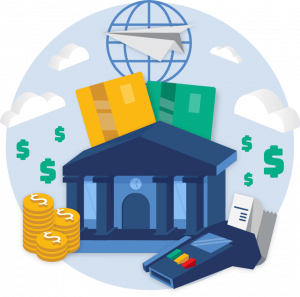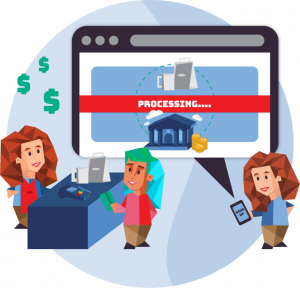Ways to Accept Credit Card Payments
Learn About In-Store, Mobile & Online Credit Card Processing
There are almost too many ways to accept credit card payments. Too many providers. Too many hardware and software options. And too little guidance on which options are necessary and which ones aren’t. It’s no wonder so many new business owners aren’t sure where to turn.
Below, you’ll find the guided tour you need. In the end, you’ll be less confused about the available ways to accept credit card payments, less open to suggestion, and more resolute in the decisions you make for your business.

Ways to Accept Credit Cards:
What You'll Discover Below
Payment Processing 101
With so many ways to accept credit card payments, understanding your options can help you make the right choices for your business.
Want to know more about payment processing as a business owner? Click the button below to access our paymentprocessing guide.
3 Ways to Accept Credit Card Payments
You’re going to have a ton of choices for how to accept credit card payments, but the basic breakdown is pretty simple. In general, you’ll accept credit card payments either:
- At a traditional storefront (in-store payments),
- On the go (wireless or mobile payments), or
- Through a website or E-marketplace (online payments).
Note that we’re distinguishing in-store payments from wireless/mobile payments because of the different hardware and software options available, not because traditional storefronts never use wireless terminals or mobile payment technology. In fact they often do, just as many business sell their products and services online while also accepting in-person payments.
But these simple categories are a good baseline to start with because they can help you weed out payment options that you definitely don’t need based on how you do business or want to do business.
Merchant Accounts
Whether you accept payments in-store, on the go, or online, you’ll need access to a merchant account to process those payments. A merchant account is a line of credit combined with a service agreement that determines the rates you’ll pay for the transactions you process and any additional services you receive.
There are essentially two ways to get access to a merchant account. You can apply for a dedicated merchant account with a payment processor, or you can process payments through an aggregated merchant account provided by a payment service provider (PSP).
We discuss the benefits and drawbacks of each option at our page on merchant accounts, along with information on how to apply for a merchant account. For now, just keep in mind that getting a dedicated merchant account is the path used by most businesses that want stable accounts, lower rates, and a wide range of processing tools at their disposal.
Why Accept Credit Card Payments?
The simple answer is that your customers will expect it. Gone are the days when any but the most established small businesses can forgo accepting credit card payments. People simply don’t carry much cash, if any, and paying with credit cards and debit cards has become a norm.
But simple demand isn’t the only reason to accept credit card payments at your business. Here are some key benefits worth considering:
- More Sales & Higher Sales: Most businesses also experience an increase in sales and higher average tickets—simply because people are more inclined to buy (and spend more) when they have the option to pay with a card.
- More Ways to Do Business: If you don’t accept card payments, you’re pretty much tied to a traditional storefront and face-to-face cash payments. Accepting card payments opens up the possibility of mobile payments for deliveries, online payments through an online store, and recurring payments for subscription services.
- More Accurate Accounting: Cash has to be counted, stored securely, and transported to the bank. This introduces the possibility of human error and employee theft—problems greatly reduced when most of your sales don’t involve cash at all.
That said, it isn’t always easy to translate these advantages into a concrete decision on which payment options are right for you. We’ll take a detailed look at each of the 3 main ways to accept credit card payments in the sections below.
In-Store Credit Card Payments
With in-store payments, your customer is standing right in front of you and presents a card as payment. So long as you swipe, dip, or tap the card at your payment terminal, the transaction is considered “card-present,” and you’ll usually pay lower credit card processing fees for the transaction.
Here are two ways to accept in-store credit card payments:
A standalone terminal is a point-of-sale (POS) system that sends transaction information to your payment processor, but which isn’t integrated with any other software.
These are the little box-shaped devices we’re probably all familiar with. They typically sit on counter-tops next to cash registers and use a dial-up or wired internet connection to relay transaction information to a merchant’s payment processor.
The benefits of traditional payment terminals are pretty straightforward:
- They’re cheap: All but the top-of-the-line desktop terminals will only set your business back a few hundred bucks, and processors will often discount a terminal (or even give it away) if you go with one of the their in-house options.
- They’re secure: Though simple and lacking in bells and whistles, traditional payment terminals tend to be more secure than mobile and online payment options.
- They’re easy to use: Most traditional payment terminals are “plug and play.” Your processor sends you the device already outfitted with its encryption key and relatively simple instructions for setting it up. Bring the device online, and you’re pretty much ready to go.
- They’re versatile: With a traditional payment terminal, you can typically accept credit cards, debit cards, gift cards, and EBT payments, depending on the payment options you request from your processor. Most payment terminals are also outfitted with EMV chip technology, and you can manually key-in card information as well.
The trouble is that traditional payment terminals are 1) immobile and 2) typically capable of little else beyond payment processing.
But if your business operates in a single place, doesn’t need a mobile or wireless payment option, and doesn’t need a bunch of bells and whistles like inventory management and sales tracking, a traditional payment terminal could be right for you.
Integrated POS systems can do everything standalone terminals do, but they go beyond merely processing payments. Instead, they integrate various hardware and software solutions to include features like inventory tracking, sales analytics, and barcode scanning.
Integrated POS systems are complex and can be pretty expensive, but their benefits are clear:
- A Streamlined Checkout Process: Instead of you or an employee entering a sales total at a cash register (and then entering that total again in a standalone terminal), an integrated POS system can do it all for you—pulling accurate prices automatically and reducing the chance of human error along the way.
- Integrated Business Management Tools: With an integrated POS system, you’ll have a range of options for combining diverse aspects of your business into a single system, whether that’s tracking your sales, inventory or business expenses, or tracking employee time-cards and server tips. This is the sense in which integrated POS systems are “integrated”—they take elements of business management that were traditionally handled separately and combine them into a single system.
- Multiple Hardware Options: Depending on your business’s needs and the POS system you choose, you’ll have different options for the overall look and feel of your point of sale. This could include customer-facing displays, PIN pads, cash drawers, and bar-code scanners—among numerous other possibilities.
Note, however, that a sophisticated integrated POS system can cost hundreds or thousands of dollars depending on model and brand, and some systems will include set-up fees and monthly fees.
If you’re a relatively new business or running a small operation, you’ll have to weigh whether the conveniences of an integrated POS system justify the additional costs involved or not.
Wireless & Mobile Credit Card Payments
For businesses that operate on the go, you’ll find a variety of wireless or mobile payment processing solutions on the market, from wireless terminals that operate essentially like standalone terminals to card swiping technology that works through a smart phone or tablet.
Of course, “on the go” can mean a lot of things. Maybe your business has a fixed location but sends employees out on service calls. Or, maybe you do business solely at locations that require a mobile payment solution if you want to accept credit card payments (such as at farmers markets or crafts fairs).
In any case, the card payment industry has you covered. Just keep in mind that some wireless and mobile solutions are “proprietary” in the sense that they’re tied to a specific service provider (such as Square’s numerous products), while other solutions will work with more than one payment processor.
Wireless terminals are usually a lot like traditional standalone terminals, except that they connect through a Wi-Fi connection instead of a land-line or wired internet connection. Delivery services, taxi cab services, home-repair services—these are just a few business types that could benefit from wireless credit card processing.
The main benefits of wireless terminals include the ability to process multiple types of payments (credit cards, debit cards, or more), and the ability to process payments at multiple locations. Indeed, wireless terminals aren’t just for businesses that need to process payments “on the go.” They’re also valuable for restaurants and other businesses that would benefit from taking payments at multiple locations in the same store—such as terminals placed at tables or terminals that can be used by servers to input orders directly instead of writing them out by hand.
The drawbacks to using a wireless payment terminal mainly come down to costs and connectivity. You’ll need a good connection (Wi-Fi or cellular) to ensure that the terminal works when you need it, and that’s not always something you can control, particularly when you’re working off location.
You can also (typically) expect to pay more for a wireless terminal than a standalone wired terminal—the ordinary payment terminals we discussed above—and this is especially true for so-called “smart terminals” that come with business management tools beyond that of mere payment processing.
Although wireless terminals are technically “mobile,” the term “mobile credit card readers” usually refers to technology that allows you to accept payments through a mobile device (typically a tablet or a smart phone).
Basically, you pair your phone or tablet with a mobile processing app that lets you either:
- enter card information directly, or
- plug in a device for swiping, tapping, or chipping your customer’s card.
The main advantages of mobile credit card readers come down to their simplicity and convenience. They allow you to process payments anywhere where you can get a good Wi-Fi connection or cellular signal, and they work with technology most of us already have on hand. This can be particularly useful for sole proprietors without a lot of employees or hobbyists looking to make a bit of extra money on the side.
The only real downside (potentially) is the costs involved, which can vary widely. If you work with a payment service provider (PSP) that specializes in mobile payments, you’ll likely pay far less for the mobile processing technology than if you sign up with a more traditional payment processor and get a dedicated merchant account. But you can also expect to pay higher transaction fees when you process payments through a PSP.
Online Credit Card Payments
Accepting credit card payments online is a different bird entirely. Here, you won’t be using a traditional standalone terminal, an integrated POS system, or a wireless/mobile option for processing payments—because those all presuppose face-to-face interactions between you and your customers.
Instead, you’ll need 1) a website for interacting with customers and making sales, and 2) a payment gateway for securely sending transaction information from the website to your business’s payment processor.
In general, you can accept payments through a website of your own, or you can do so through an E-marketplace (a third-party platform like Etsy). E-marketplaces typically charge merchants fees for making sales on their platforms, so processing payments through an E-marketplace will generate additional costs for your business.
What is a Payment Gateway?
Payment gateways are basically pathways that securely transmit transaction information from a website to a payment processor.
There are a few key points to consider when it comes to payment gateways:
- If you have (or will have) your own website, you’ll have the option to use a hosted payment gateway or an integrated payment gateway.
- Hosted payment gateways send your customer to a different website (the “host page”) when the time comes to make a credit card payment.
- Integrated payment gateways keep your customers on your website throughout the transaction process.
Businesses tend to use hosted payment gateways when they lack the funds or technical expertise necessary to use an integrated payment gateway, or when they simply prefer to outsource most of the responsibilities for payment security to a third party.
One clear drawback to using a hosted payment gateway, however, is that your customers will leave your website to pay. This is jarring for some consumers and might cause them to hesitate, particularly if the hosted page doesn’t resemble your website. With an integrated payment gateway, your customers never leave your website, which can increase trust and create a more cohesive customer experience overall.
Benefits of Accepting Online Credit Card Payments
For wholly online businesses, it’s almost pointless to speak of the benefits and drawbacks of accepting credit card payments online. The costs can be forbidding, and the options can be bewildering, but the online payment option itself is a basic necessity.
For businesses that operate out of a traditional storefront, however, the benefits of accepting payments online really depend on how you want to do business. Accepting online payments can open up a range of possibilities that traditional in-person payments don’t provide, from reaching potential customers outside of your immediate region to streamlining the payment process for deliveries to replacing call-in orders at restaurants.
However, all online credit card payments are considered “card-not-present”—which means you can expect higher processing costs in general when you accept credit card payments online. If you can balance these benefits with the increased fees you’ll pay for processing credit card payments online, venturing into the world of online payments might be right for you.
For a deeper dive into how online payments work, take a look at our page on online credit card processing.






